A Comprehensive Report on BATNA, ZOPA, and Negotiation Strategies
VerifiedAdded on 2022/08/19
|15
|3036
|27
Report
AI Summary
This report provides a comprehensive analysis of BATNA (Best Alternative to a Negotiated Agreement) and ZOPA (Zone of Possible Agreement) in the context of negotiation processes. It begins by defining BATNA and its significance, explaining how it serves as a key factor for successful negotiat...
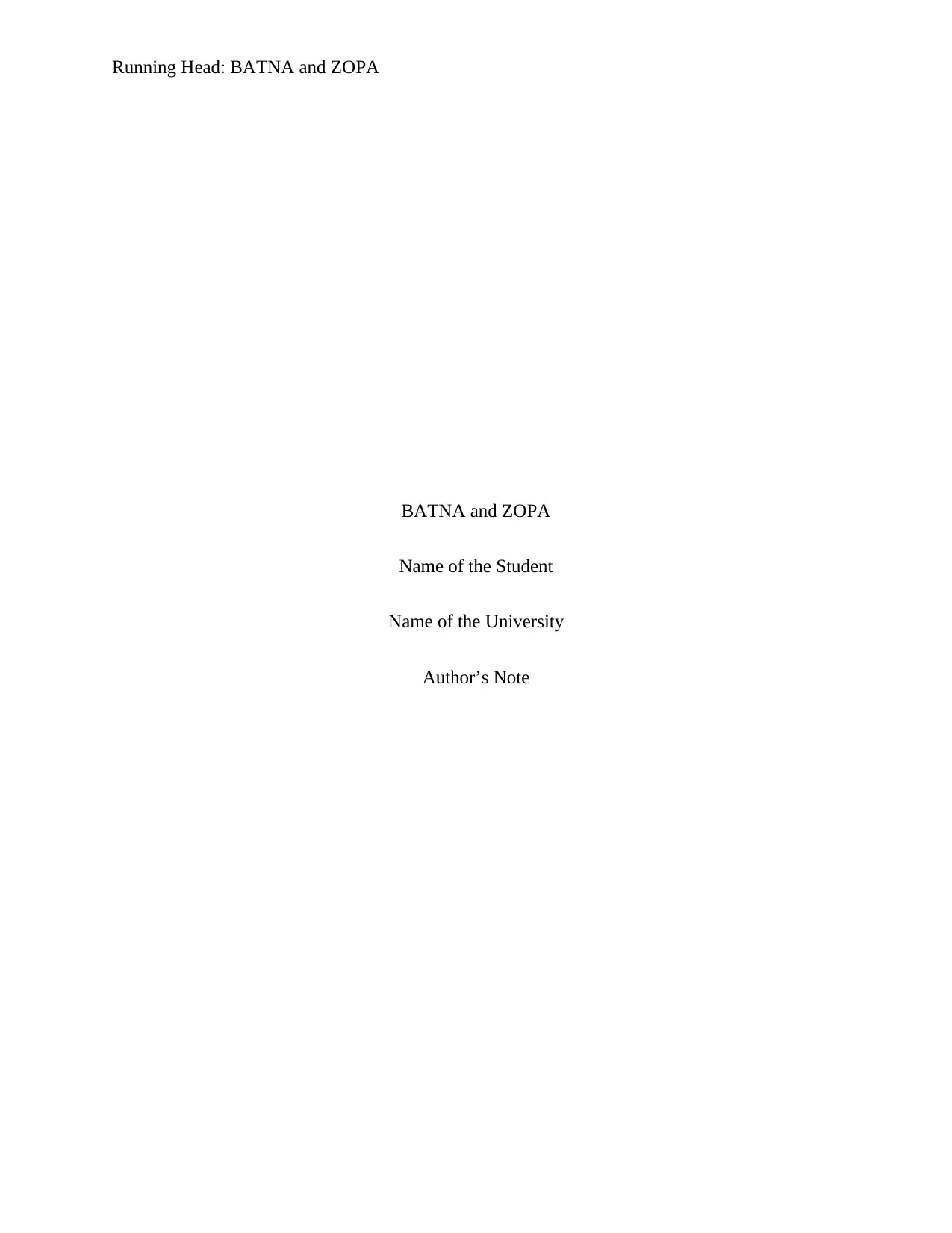
Running Head: BATNA and ZOPA
BATNA and ZOPA
Name of the Student
Name of the University
Author’s Note
BATNA and ZOPA
Name of the Student
Name of the University
Author’s Note
Paraphrase This Document
Need a fresh take? Get an instant paraphrase of this document with our AI Paraphraser
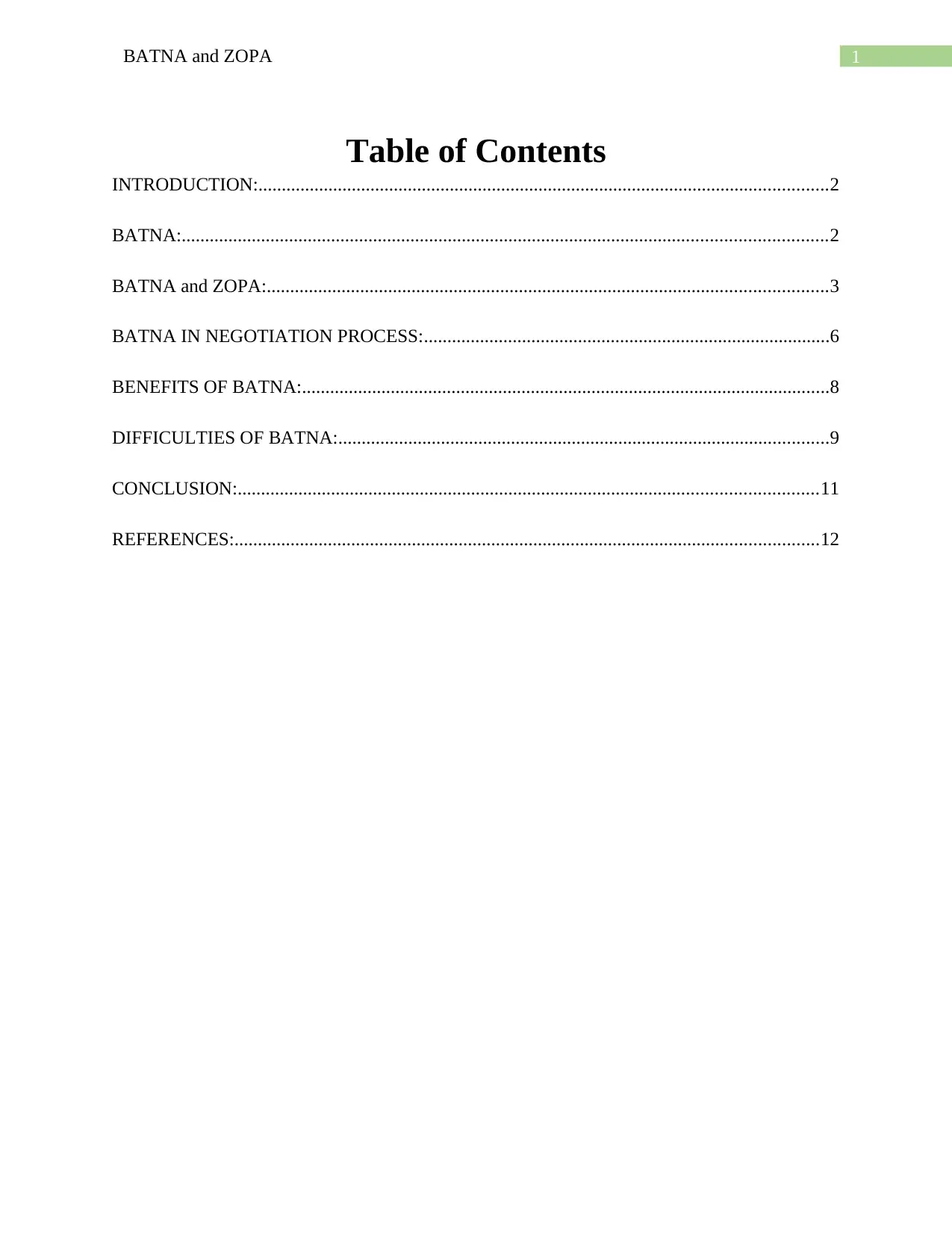
1BATNA and ZOPA
Table of Contents
INTRODUCTION:..........................................................................................................................2
BATNA:..........................................................................................................................................2
BATNA and ZOPA:........................................................................................................................3
BATNA IN NEGOTIATION PROCESS:.......................................................................................6
BENEFITS OF BATNA:.................................................................................................................8
DIFFICULTIES OF BATNA:.........................................................................................................9
CONCLUSION:............................................................................................................................11
REFERENCES:.............................................................................................................................12
Table of Contents
INTRODUCTION:..........................................................................................................................2
BATNA:..........................................................................................................................................2
BATNA and ZOPA:........................................................................................................................3
BATNA IN NEGOTIATION PROCESS:.......................................................................................6
BENEFITS OF BATNA:.................................................................................................................8
DIFFICULTIES OF BATNA:.........................................................................................................9
CONCLUSION:............................................................................................................................11
REFERENCES:.............................................................................................................................12

2BATNA and ZOPA
INTRODUCTION:
There are various styles of negotiation where one involves the adversarial approach
leading to aggressive, coercive, and deceptive methods for the negotiation process while others
are the soft style which involves friendly, trust, compromising and methods avoiding conflict
between the parties (Fisher, Ury and Patton 2011). However, it is an established notion that the
negotiation process should be independent of the cultural differences, varied cognitive behavior
and biasness which may influence the negotiation leading to separation of terms and conditions
of agreement from the objective of negotiation (Thompson, Wang and Gunia 2010).
The aim of the thesis is to establish the benefits and difficulties of BATNA along with the
comparison of BATNA with ZOPA and understanding of BATNA in the negotiation process.
BATNA:
BATNA or the Best Alternatives To a Negotiated Agreement is defined as the best and
the most advantageous alternative to the course of action as initiated and discussed in
negotiations (Brett, Pinkley and Jackofsky 1996). These alternatives are bargained terms and
conditions to the original ones based on which the agreement may reach a conclusion (Hawkins
and Hudson 1990). BATNA is the key factor for successful negotiations. However, it is
important for the process of bargaining to continue with all the factors into consideration
including that of relationship value, value for time and money and the interests of both the
parties.
INTRODUCTION:
There are various styles of negotiation where one involves the adversarial approach
leading to aggressive, coercive, and deceptive methods for the negotiation process while others
are the soft style which involves friendly, trust, compromising and methods avoiding conflict
between the parties (Fisher, Ury and Patton 2011). However, it is an established notion that the
negotiation process should be independent of the cultural differences, varied cognitive behavior
and biasness which may influence the negotiation leading to separation of terms and conditions
of agreement from the objective of negotiation (Thompson, Wang and Gunia 2010).
The aim of the thesis is to establish the benefits and difficulties of BATNA along with the
comparison of BATNA with ZOPA and understanding of BATNA in the negotiation process.
BATNA:
BATNA or the Best Alternatives To a Negotiated Agreement is defined as the best and
the most advantageous alternative to the course of action as initiated and discussed in
negotiations (Brett, Pinkley and Jackofsky 1996). These alternatives are bargained terms and
conditions to the original ones based on which the agreement may reach a conclusion (Hawkins
and Hudson 1990). BATNA is the key factor for successful negotiations. However, it is
important for the process of bargaining to continue with all the factors into consideration
including that of relationship value, value for time and money and the interests of both the
parties.
⊘ This is a preview!⊘
Do you want full access?
Subscribe today to unlock all pages.

Trusted by 1+ million students worldwide

3BATNA and ZOPA
Fig: Examples of BATNA (Brett, Pinkley and Jackofsky 1996)
The above figure explains the BATNA in various explains with respect to that of an
engineer as an employee and that of the Company who is intending to employ the person.
BATNA and ZOPA:
ZOPA or the Zone Of Possible Agreement or the range of bargaining where the parties
reach the minimum target as expected by them from the given negotiation. It means that the
successful negotiation can be reached only by considering the interests of the parties at the
minimum bargain extracting from each other’s interests and values. Thus it can be explained that
ZOPA is the most essential and critical point for the establishment of agreements between the
parties. The analysis of ZOPA attained by the parties can be attained by the statements made by
the parties in the course of negotiation.
Fig: Examples of BATNA (Brett, Pinkley and Jackofsky 1996)
The above figure explains the BATNA in various explains with respect to that of an
engineer as an employee and that of the Company who is intending to employ the person.
BATNA and ZOPA:
ZOPA or the Zone Of Possible Agreement or the range of bargaining where the parties
reach the minimum target as expected by them from the given negotiation. It means that the
successful negotiation can be reached only by considering the interests of the parties at the
minimum bargain extracting from each other’s interests and values. Thus it can be explained that
ZOPA is the most essential and critical point for the establishment of agreements between the
parties. The analysis of ZOPA attained by the parties can be attained by the statements made by
the parties in the course of negotiation.
Paraphrase This Document
Need a fresh take? Get an instant paraphrase of this document with our AI Paraphraser
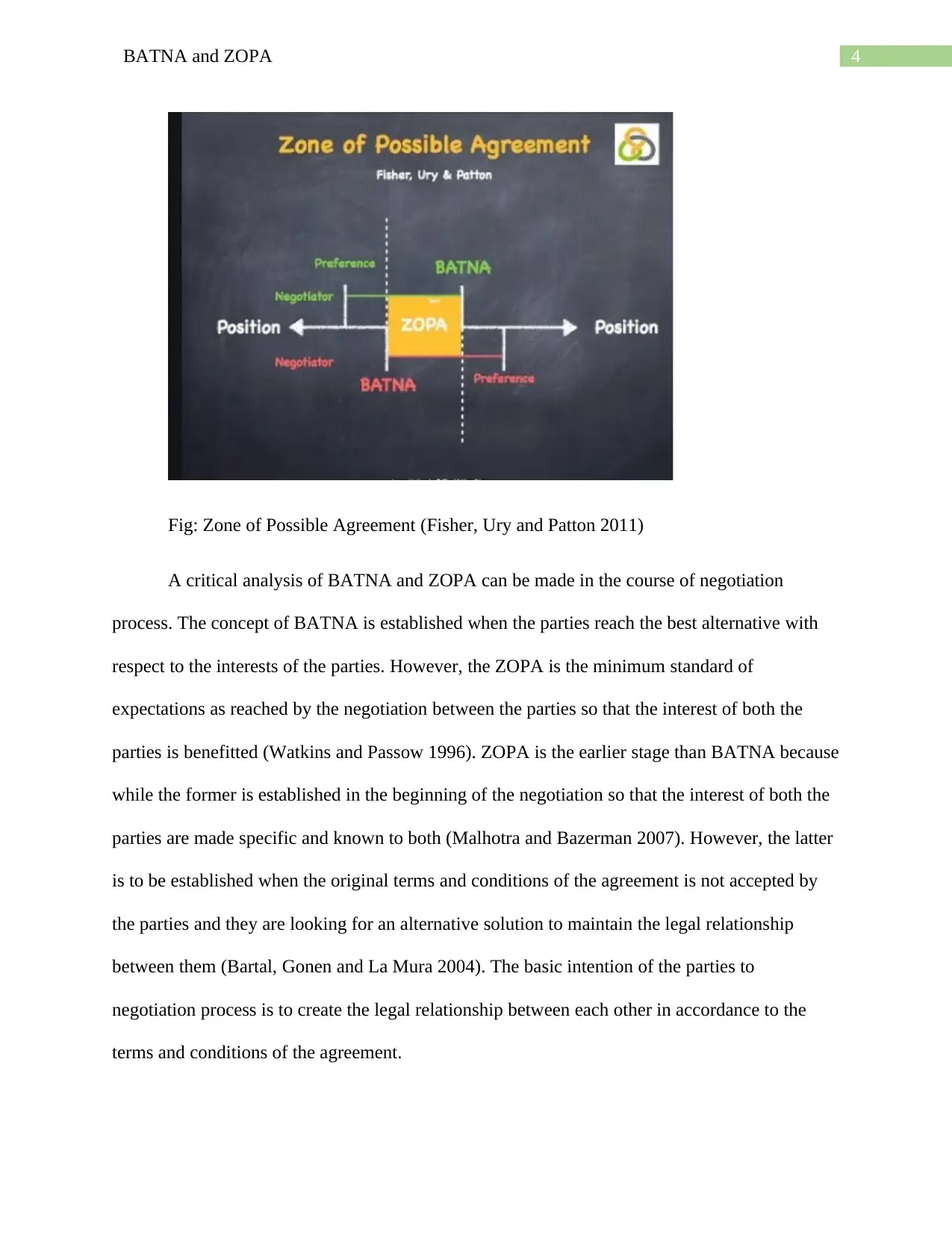
4BATNA and ZOPA
Fig: Zone of Possible Agreement (Fisher, Ury and Patton 2011)
A critical analysis of BATNA and ZOPA can be made in the course of negotiation
process. The concept of BATNA is established when the parties reach the best alternative with
respect to the interests of the parties. However, the ZOPA is the minimum standard of
expectations as reached by the negotiation between the parties so that the interest of both the
parties is benefitted (Watkins and Passow 1996). ZOPA is the earlier stage than BATNA because
while the former is established in the beginning of the negotiation so that the interest of both the
parties are made specific and known to both (Malhotra and Bazerman 2007). However, the latter
is to be established when the original terms and conditions of the agreement is not accepted by
the parties and they are looking for an alternative solution to maintain the legal relationship
between them (Bartal, Gonen and La Mura 2004). The basic intention of the parties to
negotiation process is to create the legal relationship between each other in accordance to the
terms and conditions of the agreement.
Fig: Zone of Possible Agreement (Fisher, Ury and Patton 2011)
A critical analysis of BATNA and ZOPA can be made in the course of negotiation
process. The concept of BATNA is established when the parties reach the best alternative with
respect to the interests of the parties. However, the ZOPA is the minimum standard of
expectations as reached by the negotiation between the parties so that the interest of both the
parties is benefitted (Watkins and Passow 1996). ZOPA is the earlier stage than BATNA because
while the former is established in the beginning of the negotiation so that the interest of both the
parties are made specific and known to both (Malhotra and Bazerman 2007). However, the latter
is to be established when the original terms and conditions of the agreement is not accepted by
the parties and they are looking for an alternative solution to maintain the legal relationship
between them (Bartal, Gonen and La Mura 2004). The basic intention of the parties to
negotiation process is to create the legal relationship between each other in accordance to the
terms and conditions of the agreement.
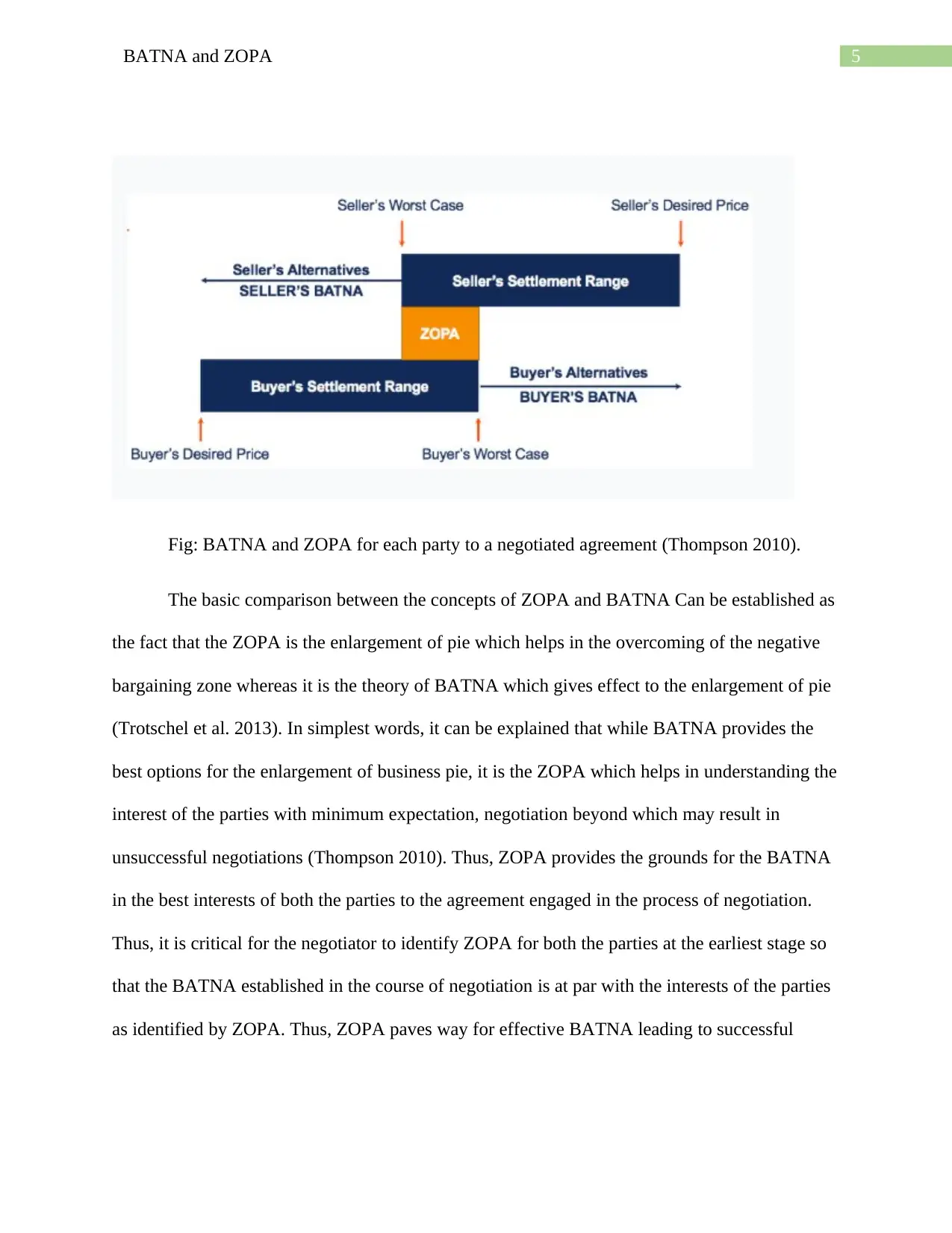
5BATNA and ZOPA
Fig: BATNA and ZOPA for each party to a negotiated agreement (Thompson 2010).
The basic comparison between the concepts of ZOPA and BATNA Can be established as
the fact that the ZOPA is the enlargement of pie which helps in the overcoming of the negative
bargaining zone whereas it is the theory of BATNA which gives effect to the enlargement of pie
(Trotschel et al. 2013). In simplest words, it can be explained that while BATNA provides the
best options for the enlargement of business pie, it is the ZOPA which helps in understanding the
interest of the parties with minimum expectation, negotiation beyond which may result in
unsuccessful negotiations (Thompson 2010). Thus, ZOPA provides the grounds for the BATNA
in the best interests of both the parties to the agreement engaged in the process of negotiation.
Thus, it is critical for the negotiator to identify ZOPA for both the parties at the earliest stage so
that the BATNA established in the course of negotiation is at par with the interests of the parties
as identified by ZOPA. Thus, ZOPA paves way for effective BATNA leading to successful
Fig: BATNA and ZOPA for each party to a negotiated agreement (Thompson 2010).
The basic comparison between the concepts of ZOPA and BATNA Can be established as
the fact that the ZOPA is the enlargement of pie which helps in the overcoming of the negative
bargaining zone whereas it is the theory of BATNA which gives effect to the enlargement of pie
(Trotschel et al. 2013). In simplest words, it can be explained that while BATNA provides the
best options for the enlargement of business pie, it is the ZOPA which helps in understanding the
interest of the parties with minimum expectation, negotiation beyond which may result in
unsuccessful negotiations (Thompson 2010). Thus, ZOPA provides the grounds for the BATNA
in the best interests of both the parties to the agreement engaged in the process of negotiation.
Thus, it is critical for the negotiator to identify ZOPA for both the parties at the earliest stage so
that the BATNA established in the course of negotiation is at par with the interests of the parties
as identified by ZOPA. Thus, ZOPA paves way for effective BATNA leading to successful
⊘ This is a preview!⊘
Do you want full access?
Subscribe today to unlock all pages.

Trusted by 1+ million students worldwide

6BATNA and ZOPA
negotiations. The critical aspect is the identification of ZOPA at the earliest stage of negotiation
which can establish a positive platform for the enlargement of business pie.
BATNA IN NEGOTIATION PROCESS:
BATNA is the influencing factor in the process of negotiation on the ground that the
negotiating parties shall be open to the varied terms and conditions for the alternatives to the plan
as laid down in the terms and conditions of the agreement (Pinkley, Neale and Bennett 1994).
The sequential approach to the contracting terms as established by negotiations is generally
based on favorism. The party with less favoured terms and conditions initiates the negotiation
and establish favourable terms and conditions subject to agreement and further negotiation by the
other party (Kim and Fragale 2005). Thus, it is the party with the less favoured terms and
conditions who create BATNA of a proposed contract which is subject to acceptance or further
negotiation by the other party.
Fig: BATNA in Negotiation Process (Pinkley, Neale and Bennett 1994)
negotiations. The critical aspect is the identification of ZOPA at the earliest stage of negotiation
which can establish a positive platform for the enlargement of business pie.
BATNA IN NEGOTIATION PROCESS:
BATNA is the influencing factor in the process of negotiation on the ground that the
negotiating parties shall be open to the varied terms and conditions for the alternatives to the plan
as laid down in the terms and conditions of the agreement (Pinkley, Neale and Bennett 1994).
The sequential approach to the contracting terms as established by negotiations is generally
based on favorism. The party with less favoured terms and conditions initiates the negotiation
and establish favourable terms and conditions subject to agreement and further negotiation by the
other party (Kim and Fragale 2005). Thus, it is the party with the less favoured terms and
conditions who create BATNA of a proposed contract which is subject to acceptance or further
negotiation by the other party.
Fig: BATNA in Negotiation Process (Pinkley, Neale and Bennett 1994)
Paraphrase This Document
Need a fresh take? Get an instant paraphrase of this document with our AI Paraphraser
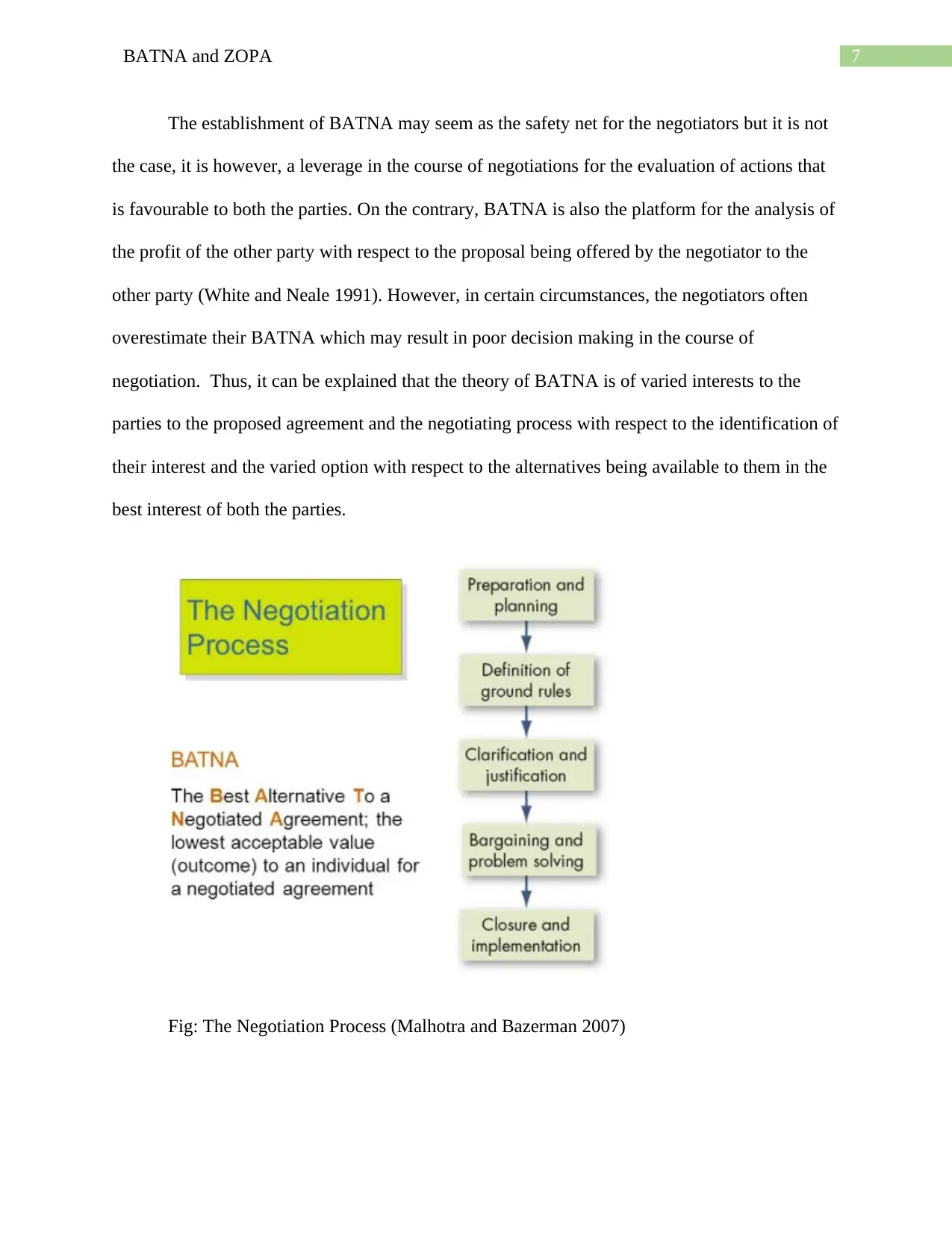
7BATNA and ZOPA
The establishment of BATNA may seem as the safety net for the negotiators but it is not
the case, it is however, a leverage in the course of negotiations for the evaluation of actions that
is favourable to both the parties. On the contrary, BATNA is also the platform for the analysis of
the profit of the other party with respect to the proposal being offered by the negotiator to the
other party (White and Neale 1991). However, in certain circumstances, the negotiators often
overestimate their BATNA which may result in poor decision making in the course of
negotiation. Thus, it can be explained that the theory of BATNA is of varied interests to the
parties to the proposed agreement and the negotiating process with respect to the identification of
their interest and the varied option with respect to the alternatives being available to them in the
best interest of both the parties.
Fig: The Negotiation Process (Malhotra and Bazerman 2007)
The establishment of BATNA may seem as the safety net for the negotiators but it is not
the case, it is however, a leverage in the course of negotiations for the evaluation of actions that
is favourable to both the parties. On the contrary, BATNA is also the platform for the analysis of
the profit of the other party with respect to the proposal being offered by the negotiator to the
other party (White and Neale 1991). However, in certain circumstances, the negotiators often
overestimate their BATNA which may result in poor decision making in the course of
negotiation. Thus, it can be explained that the theory of BATNA is of varied interests to the
parties to the proposed agreement and the negotiating process with respect to the identification of
their interest and the varied option with respect to the alternatives being available to them in the
best interest of both the parties.
Fig: The Negotiation Process (Malhotra and Bazerman 2007)

8BATNA and ZOPA
In the above figure, it has been explained that the process of negotiation is a combination
of various steps starting from the preparedness and planning of the negotiable terms and
conditions. BATNA and ZOPA are identified at this step based on which the Bargaining and
Problem Solving Step is initiated. The steps involving the ground rules and that of clarification
and justification involves the part where the parties clarify and justify and terms and conditions
which they may have not understood. Thus, the process of negotiation is a complete set of
understanding of the proposal and acting upon it with best interest of both the parties.
BENEFITS OF BATNA:
There are various benefits with respect to the importance of BATNA stating that:
It establishes the alternative grounds to the offered terms and conditions, in case the
negotiation falls through (Pinkley, Neale and Bennett 1994).
BATNA establishes best alternatives to the parties and hence, it gives a negotiating
power to the negotiator to initiate bargains considering his best interests along with that
of the other party without compromising his ZOPA (Kim, Pinkley and Fragale 2005).
BATNA and WATNA are the parallel concepts of negotiation. It means that what is not
best, is the worst alternative to the negotiation (Andrade et al. 2009). Thus, BATNA also
establishes the willingness to accept the terms and conditions of the agreement as
negotiated. In other words, BATNA establishes the reservation point at which the
negotiator is willing to accept the proposal.
The importance of BATNA lies in the fact that one should never enter into negotiations
without knowing their BATNA (Kujala, Murtoaro and Artto 2007). In other words, it
means that the BATNA also provides WATNA to the party meaning the point at which
In the above figure, it has been explained that the process of negotiation is a combination
of various steps starting from the preparedness and planning of the negotiable terms and
conditions. BATNA and ZOPA are identified at this step based on which the Bargaining and
Problem Solving Step is initiated. The steps involving the ground rules and that of clarification
and justification involves the part where the parties clarify and justify and terms and conditions
which they may have not understood. Thus, the process of negotiation is a complete set of
understanding of the proposal and acting upon it with best interest of both the parties.
BENEFITS OF BATNA:
There are various benefits with respect to the importance of BATNA stating that:
It establishes the alternative grounds to the offered terms and conditions, in case the
negotiation falls through (Pinkley, Neale and Bennett 1994).
BATNA establishes best alternatives to the parties and hence, it gives a negotiating
power to the negotiator to initiate bargains considering his best interests along with that
of the other party without compromising his ZOPA (Kim, Pinkley and Fragale 2005).
BATNA and WATNA are the parallel concepts of negotiation. It means that what is not
best, is the worst alternative to the negotiation (Andrade et al. 2009). Thus, BATNA also
establishes the willingness to accept the terms and conditions of the agreement as
negotiated. In other words, BATNA establishes the reservation point at which the
negotiator is willing to accept the proposal.
The importance of BATNA lies in the fact that one should never enter into negotiations
without knowing their BATNA (Kujala, Murtoaro and Artto 2007). In other words, it
means that the BATNA also provides WATNA to the party meaning the point at which
⊘ This is a preview!⊘
Do you want full access?
Subscribe today to unlock all pages.

Trusted by 1+ million students worldwide

9BATNA and ZOPA
the party should stop negotiation and may accept or reject the negotiated terms and
conditions of the agreement or reject the same.
BATNA is the leverage for the negotiator to bargain the terms and conditions of the
contract or the agreement to favor the interest of the negotiator as the best alternative.
Thus, a strong BATNA allows the negotiator to either confirm the deal with strong
favourable terms and conditions to the agreement or not accept the deal leading to better
alternative plan.
BATNA imbibes flexibility in the terms and conditions of the agreement as proposed by
the party leading to the consideration of available alternatives.
Thus, it can be explained that the concept of BATNA is the concept which allows the
negotiate to get into negotiation of terms and conditions of the agreement with the best
alternatives that they might offer to the other party subject to the fact that the offered terms and
conditions of the agreement is favourable to the other party also (interest of both the parties
should be considered while negotiating the terms and conditions of any agreement) and the same
has been accepted by the other party. Therefore, it is important for the negotiator to assess his
BATNA as well as the WATNA thoroughly before initiating a negotiation to avoid falling out of
negotiation in process or faulty decision making of the party.
DIFFICULTIES OF BATNA:
As every coin has two sides, the theory of BATNA also suffers from certain drawbacks.
This can be explained as follows:
the party should stop negotiation and may accept or reject the negotiated terms and
conditions of the agreement or reject the same.
BATNA is the leverage for the negotiator to bargain the terms and conditions of the
contract or the agreement to favor the interest of the negotiator as the best alternative.
Thus, a strong BATNA allows the negotiator to either confirm the deal with strong
favourable terms and conditions to the agreement or not accept the deal leading to better
alternative plan.
BATNA imbibes flexibility in the terms and conditions of the agreement as proposed by
the party leading to the consideration of available alternatives.
Thus, it can be explained that the concept of BATNA is the concept which allows the
negotiate to get into negotiation of terms and conditions of the agreement with the best
alternatives that they might offer to the other party subject to the fact that the offered terms and
conditions of the agreement is favourable to the other party also (interest of both the parties
should be considered while negotiating the terms and conditions of any agreement) and the same
has been accepted by the other party. Therefore, it is important for the negotiator to assess his
BATNA as well as the WATNA thoroughly before initiating a negotiation to avoid falling out of
negotiation in process or faulty decision making of the party.
DIFFICULTIES OF BATNA:
As every coin has two sides, the theory of BATNA also suffers from certain drawbacks.
This can be explained as follows:
Paraphrase This Document
Need a fresh take? Get an instant paraphrase of this document with our AI Paraphraser

10BATNA and ZOPA
BATNA is the outcome of the two step process involving preparation and planning
(Mnookin 2003). Therefore, it is important to assess one’s BATNA before getting into
any negotiation process (Odell 2002).
Any change in circumstances like sudden rise in costs, or enforcement of a new
legislation or a statute, resulting in shift of the strength of BATNA in either side would
affect the negotiation process resulting in falling out of agreement (Murtaoro and Kujala
2007).
It has been criticized on the ground of being poorly conceptualized affecting the
agreements damaging the relationship between the parties, if the BATNA does not work
out between the parties.
It has further been criticized on the ground that it suffers from a problem of measurement
and predictability (White and Neale 1991). This means that BATNA lacks the
predictability related to the change in shift of BATNA on the side of either party like that
of sudden rise in prices, enforcement of a new legislation, confirmation of deal with the
competitors with better terms and conditions and so on. The measurement has been
criticized on the ground that the BATNA focuses on the strength of the terms and
conditions to be negotiated and not on the weaknesses related to the same.
It has then been criticized on the ground that the concept of BATNA has visions and
connotations on negotiations which are static and ethnically-centered. In other words, it
means that the concept of BATNA may amount to favourism of deals with respect to
biasness and cultural cognitive behaviors which may interfere with the objectives of the
party to negotiation. It can thus be explained that the BATNA leads to idea of favourism
BATNA is the outcome of the two step process involving preparation and planning
(Mnookin 2003). Therefore, it is important to assess one’s BATNA before getting into
any negotiation process (Odell 2002).
Any change in circumstances like sudden rise in costs, or enforcement of a new
legislation or a statute, resulting in shift of the strength of BATNA in either side would
affect the negotiation process resulting in falling out of agreement (Murtaoro and Kujala
2007).
It has been criticized on the ground of being poorly conceptualized affecting the
agreements damaging the relationship between the parties, if the BATNA does not work
out between the parties.
It has further been criticized on the ground that it suffers from a problem of measurement
and predictability (White and Neale 1991). This means that BATNA lacks the
predictability related to the change in shift of BATNA on the side of either party like that
of sudden rise in prices, enforcement of a new legislation, confirmation of deal with the
competitors with better terms and conditions and so on. The measurement has been
criticized on the ground that the BATNA focuses on the strength of the terms and
conditions to be negotiated and not on the weaknesses related to the same.
It has then been criticized on the ground that the concept of BATNA has visions and
connotations on negotiations which are static and ethnically-centered. In other words, it
means that the concept of BATNA may amount to favourism of deals with respect to
biasness and cultural cognitive behaviors which may interfere with the objectives of the
party to negotiation. It can thus be explained that the BATNA leads to idea of favourism
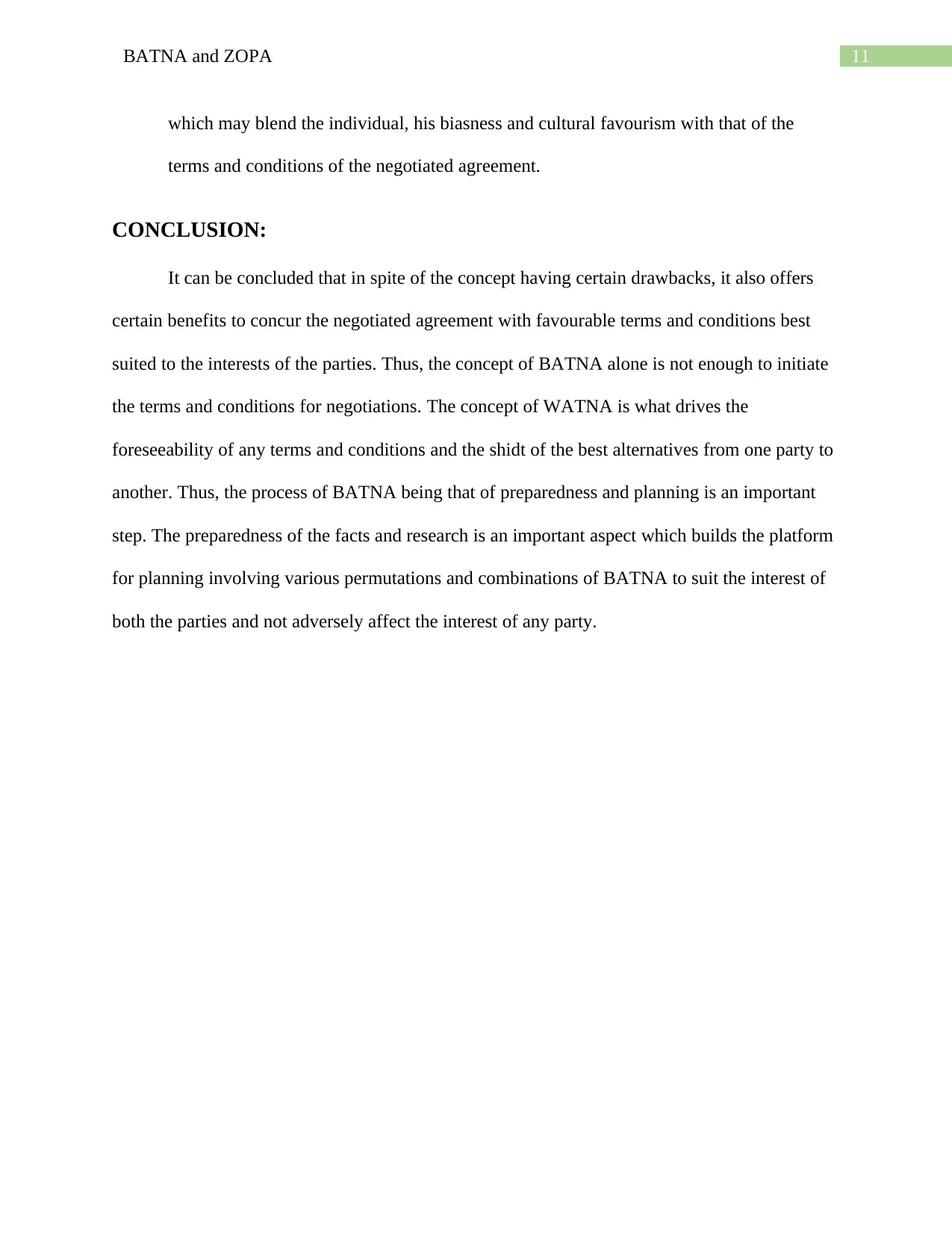
11BATNA and ZOPA
which may blend the individual, his biasness and cultural favourism with that of the
terms and conditions of the negotiated agreement.
CONCLUSION:
It can be concluded that in spite of the concept having certain drawbacks, it also offers
certain benefits to concur the negotiated agreement with favourable terms and conditions best
suited to the interests of the parties. Thus, the concept of BATNA alone is not enough to initiate
the terms and conditions for negotiations. The concept of WATNA is what drives the
foreseeability of any terms and conditions and the shidt of the best alternatives from one party to
another. Thus, the process of BATNA being that of preparedness and planning is an important
step. The preparedness of the facts and research is an important aspect which builds the platform
for planning involving various permutations and combinations of BATNA to suit the interest of
both the parties and not adversely affect the interest of any party.
which may blend the individual, his biasness and cultural favourism with that of the
terms and conditions of the negotiated agreement.
CONCLUSION:
It can be concluded that in spite of the concept having certain drawbacks, it also offers
certain benefits to concur the negotiated agreement with favourable terms and conditions best
suited to the interests of the parties. Thus, the concept of BATNA alone is not enough to initiate
the terms and conditions for negotiations. The concept of WATNA is what drives the
foreseeability of any terms and conditions and the shidt of the best alternatives from one party to
another. Thus, the process of BATNA being that of preparedness and planning is an important
step. The preparedness of the facts and research is an important aspect which builds the platform
for planning involving various permutations and combinations of BATNA to suit the interest of
both the parties and not adversely affect the interest of any party.
⊘ This is a preview!⊘
Do you want full access?
Subscribe today to unlock all pages.

Trusted by 1+ million students worldwide
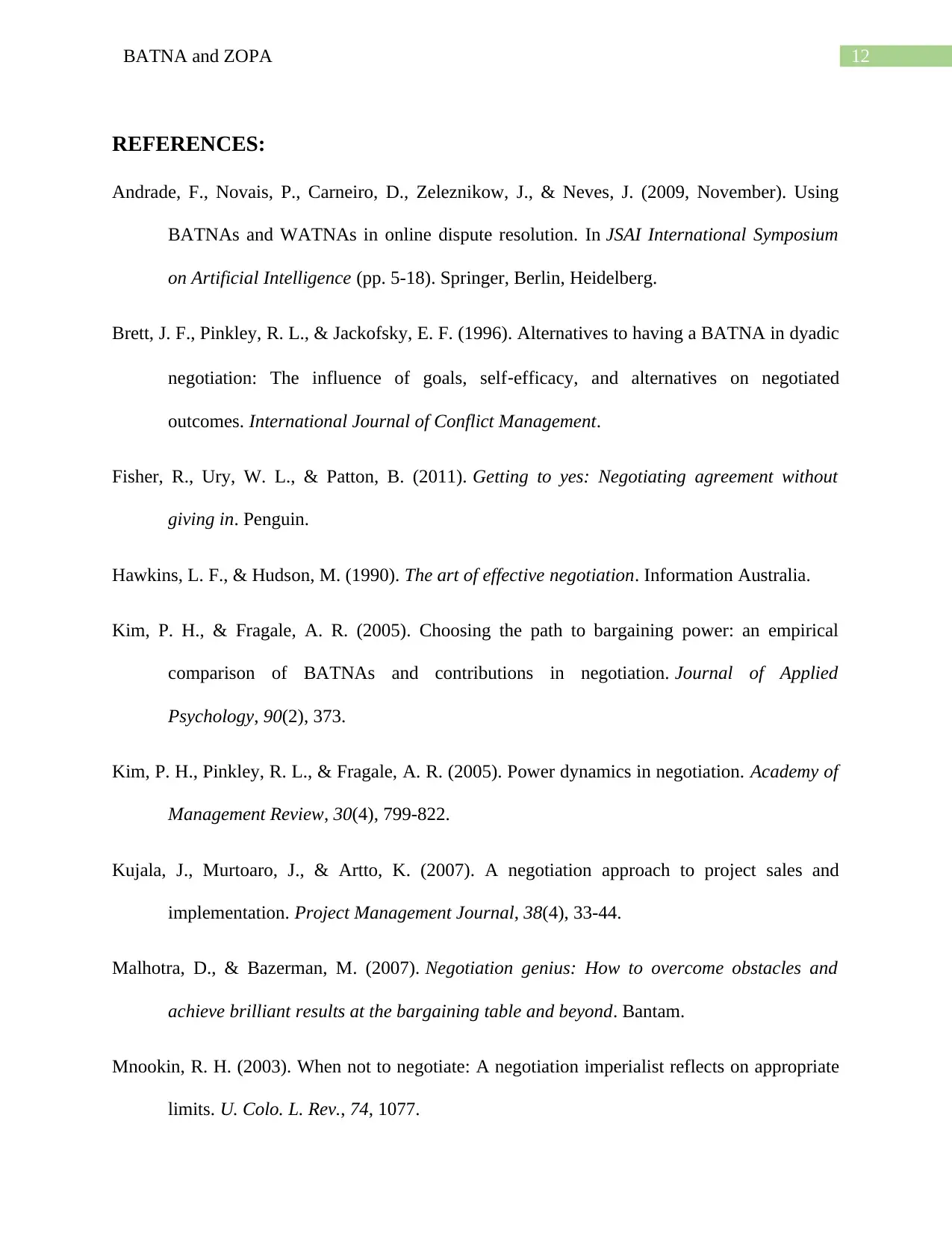
12BATNA and ZOPA
REFERENCES:
Andrade, F., Novais, P., Carneiro, D., Zeleznikow, J., & Neves, J. (2009, November). Using
BATNAs and WATNAs in online dispute resolution. In JSAI International Symposium
on Artificial Intelligence (pp. 5-18). Springer, Berlin, Heidelberg.
Brett, J. F., Pinkley, R. L., & Jackofsky, E. F. (1996). Alternatives to having a BATNA in dyadic
negotiation: The influence of goals, self‐efficacy, and alternatives on negotiated
outcomes. International Journal of Conflict Management.
Fisher, R., Ury, W. L., & Patton, B. (2011). Getting to yes: Negotiating agreement without
giving in. Penguin.
Hawkins, L. F., & Hudson, M. (1990). The art of effective negotiation. Information Australia.
Kim, P. H., & Fragale, A. R. (2005). Choosing the path to bargaining power: an empirical
comparison of BATNAs and contributions in negotiation. Journal of Applied
Psychology, 90(2), 373.
Kim, P. H., Pinkley, R. L., & Fragale, A. R. (2005). Power dynamics in negotiation. Academy of
Management Review, 30(4), 799-822.
Kujala, J., Murtoaro, J., & Artto, K. (2007). A negotiation approach to project sales and
implementation. Project Management Journal, 38(4), 33-44.
Malhotra, D., & Bazerman, M. (2007). Negotiation genius: How to overcome obstacles and
achieve brilliant results at the bargaining table and beyond. Bantam.
Mnookin, R. H. (2003). When not to negotiate: A negotiation imperialist reflects on appropriate
limits. U. Colo. L. Rev., 74, 1077.
REFERENCES:
Andrade, F., Novais, P., Carneiro, D., Zeleznikow, J., & Neves, J. (2009, November). Using
BATNAs and WATNAs in online dispute resolution. In JSAI International Symposium
on Artificial Intelligence (pp. 5-18). Springer, Berlin, Heidelberg.
Brett, J. F., Pinkley, R. L., & Jackofsky, E. F. (1996). Alternatives to having a BATNA in dyadic
negotiation: The influence of goals, self‐efficacy, and alternatives on negotiated
outcomes. International Journal of Conflict Management.
Fisher, R., Ury, W. L., & Patton, B. (2011). Getting to yes: Negotiating agreement without
giving in. Penguin.
Hawkins, L. F., & Hudson, M. (1990). The art of effective negotiation. Information Australia.
Kim, P. H., & Fragale, A. R. (2005). Choosing the path to bargaining power: an empirical
comparison of BATNAs and contributions in negotiation. Journal of Applied
Psychology, 90(2), 373.
Kim, P. H., Pinkley, R. L., & Fragale, A. R. (2005). Power dynamics in negotiation. Academy of
Management Review, 30(4), 799-822.
Kujala, J., Murtoaro, J., & Artto, K. (2007). A negotiation approach to project sales and
implementation. Project Management Journal, 38(4), 33-44.
Malhotra, D., & Bazerman, M. (2007). Negotiation genius: How to overcome obstacles and
achieve brilliant results at the bargaining table and beyond. Bantam.
Mnookin, R. H. (2003). When not to negotiate: A negotiation imperialist reflects on appropriate
limits. U. Colo. L. Rev., 74, 1077.
Paraphrase This Document
Need a fresh take? Get an instant paraphrase of this document with our AI Paraphraser
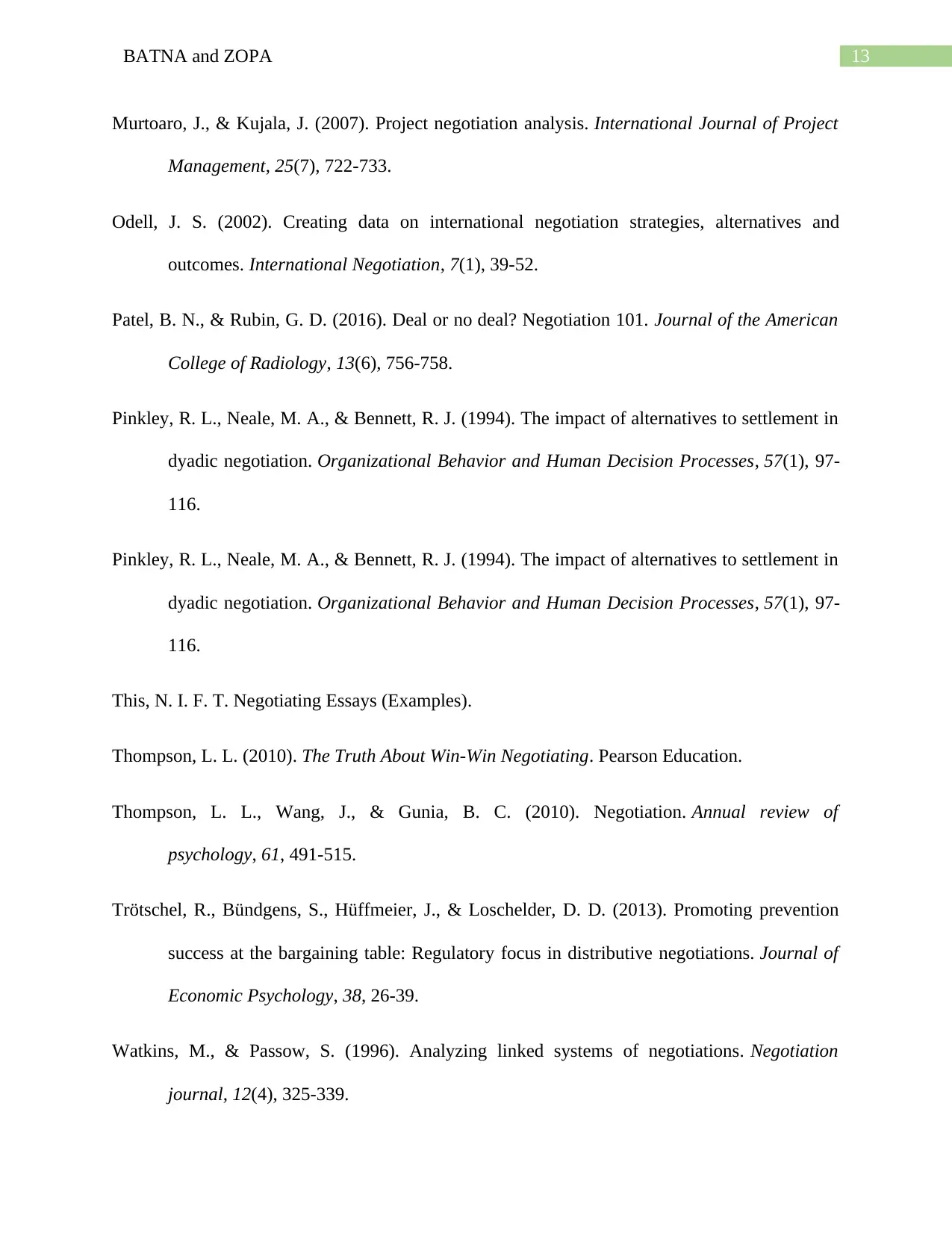
13BATNA and ZOPA
Murtoaro, J., & Kujala, J. (2007). Project negotiation analysis. International Journal of Project
Management, 25(7), 722-733.
Odell, J. S. (2002). Creating data on international negotiation strategies, alternatives and
outcomes. International Negotiation, 7(1), 39-52.
Patel, B. N., & Rubin, G. D. (2016). Deal or no deal? Negotiation 101. Journal of the American
College of Radiology, 13(6), 756-758.
Pinkley, R. L., Neale, M. A., & Bennett, R. J. (1994). The impact of alternatives to settlement in
dyadic negotiation. Organizational Behavior and Human Decision Processes, 57(1), 97-
116.
Pinkley, R. L., Neale, M. A., & Bennett, R. J. (1994). The impact of alternatives to settlement in
dyadic negotiation. Organizational Behavior and Human Decision Processes, 57(1), 97-
116.
This, N. I. F. T. Negotiating Essays (Examples).
Thompson, L. L. (2010). The Truth About Win-Win Negotiating. Pearson Education.
Thompson, L. L., Wang, J., & Gunia, B. C. (2010). Negotiation. Annual review of
psychology, 61, 491-515.
Trötschel, R., Bündgens, S., Hüffmeier, J., & Loschelder, D. D. (2013). Promoting prevention
success at the bargaining table: Regulatory focus in distributive negotiations. Journal of
Economic Psychology, 38, 26-39.
Watkins, M., & Passow, S. (1996). Analyzing linked systems of negotiations. Negotiation
journal, 12(4), 325-339.
Murtoaro, J., & Kujala, J. (2007). Project negotiation analysis. International Journal of Project
Management, 25(7), 722-733.
Odell, J. S. (2002). Creating data on international negotiation strategies, alternatives and
outcomes. International Negotiation, 7(1), 39-52.
Patel, B. N., & Rubin, G. D. (2016). Deal or no deal? Negotiation 101. Journal of the American
College of Radiology, 13(6), 756-758.
Pinkley, R. L., Neale, M. A., & Bennett, R. J. (1994). The impact of alternatives to settlement in
dyadic negotiation. Organizational Behavior and Human Decision Processes, 57(1), 97-
116.
Pinkley, R. L., Neale, M. A., & Bennett, R. J. (1994). The impact of alternatives to settlement in
dyadic negotiation. Organizational Behavior and Human Decision Processes, 57(1), 97-
116.
This, N. I. F. T. Negotiating Essays (Examples).
Thompson, L. L. (2010). The Truth About Win-Win Negotiating. Pearson Education.
Thompson, L. L., Wang, J., & Gunia, B. C. (2010). Negotiation. Annual review of
psychology, 61, 491-515.
Trötschel, R., Bündgens, S., Hüffmeier, J., & Loschelder, D. D. (2013). Promoting prevention
success at the bargaining table: Regulatory focus in distributive negotiations. Journal of
Economic Psychology, 38, 26-39.
Watkins, M., & Passow, S. (1996). Analyzing linked systems of negotiations. Negotiation
journal, 12(4), 325-339.

14BATNA and ZOPA
White, S. B., & Neale, M. A. (1991). Reservation prices, resistance points, and BATNAs:
Determining the parameters of acceptable negotiated outcomes. Negot. J., 7, 379.
White, S. B., & Neale, M. A. (1991). Reservation prices, resistance points, and BATNAs:
Determining the parameters of acceptable negotiated outcomes. Negot. J., 7, 379.
White, S. B., & Neale, M. A. (1991). Reservation prices, resistance points, and BATNAs:
Determining the parameters of acceptable negotiated outcomes. Negot. J., 7, 379.
White, S. B., & Neale, M. A. (1991). Reservation prices, resistance points, and BATNAs:
Determining the parameters of acceptable negotiated outcomes. Negot. J., 7, 379.
⊘ This is a preview!⊘
Do you want full access?
Subscribe today to unlock all pages.

Trusted by 1+ million students worldwide
1 out of 15
Related Documents
Your All-in-One AI-Powered Toolkit for Academic Success.
+13062052269
info@desklib.com
Available 24*7 on WhatsApp / Email
![[object Object]](/_next/static/media/star-bottom.7253800d.svg)
Unlock your academic potential
© 2024 | Zucol Services PVT LTD | All rights reserved.





